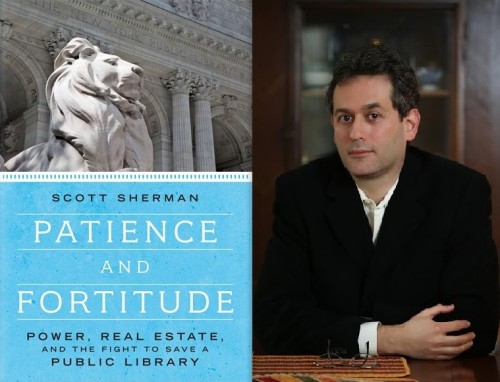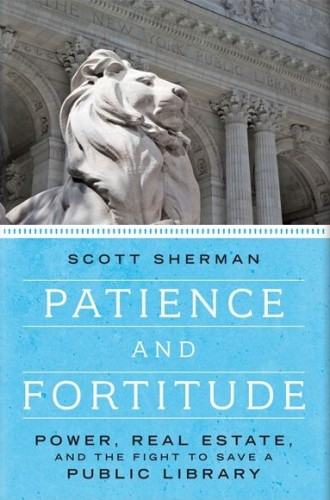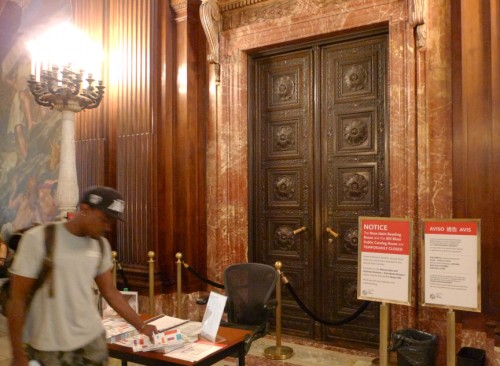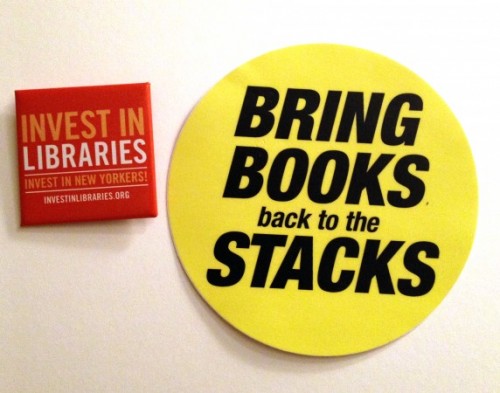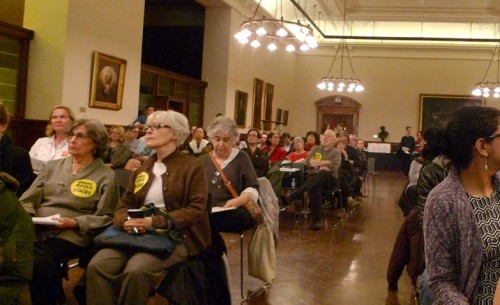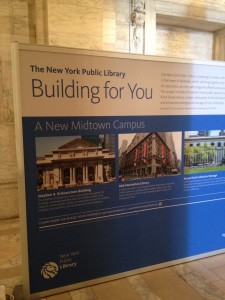Stacks, Not Snacks!
NYPL plans to open upscale cafes at two of its research libraries. The rationale? “It is important that we offer the public what they want and need while they’re in our buildings, often for hours while doing important research,” says NYPL Chief External Relations Officer Carrie Welch.
Ms. Welch seems to have missed the fact that what the public generally needs when doing “important research” is books, and a decent space in which to read them. Both of which are currently missing from the 42nd Street Library. But it’s good to know that NYPL is listening. After years of controversy about NYPL’s crippling of its research facilities, NYPL has got the message. Ms. Welch sums it up: “We have heard from our patrons that they would like refreshments.”
Can a Closed Book Start a New Chapter?
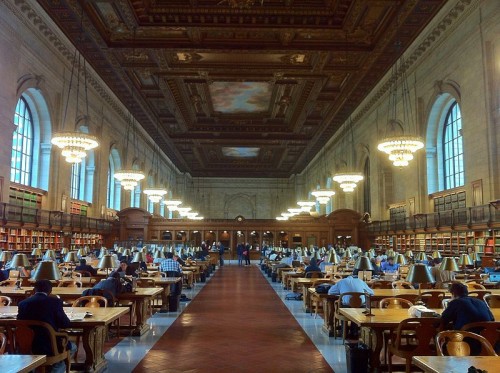
On September 16th, NYPL announced the selection of Mecanoo and Beyer Blinder Belle as architects for the $300 million renovation of the Mid-Manhattan and 42nd Street Library. Unfortunately, the news came with complete lack of transparency in either the selection process or the renovation plans.
NYPL revealed nothing about what other architects were solicited, how the various applicants planned to approach the project, and why Mecanoo was chosen for the job.
In a recent email sent to users of the 42nd Street Library, Carolyn Broomhead, the Research Community Manager at NYPL, refers to “a comprehensive program plan that will drive the work of the architects.” This program plan, prepared in collaboration with outside consultants Brightspot, has not been made public.
In the interest of greater transparency and to avoid repeating the wasted time and expense of previous design schemes NYPL should allow library patrons and other New Yorkers to read all program documents and examine all proposed plans. In order to solicit greater feedback, appropriate forums should be convened so the public can share comments and concerns about the designs with librarians.
As part of the library’s comprehensive renovation plans for the 42nd Street Library, NYPL must develop a long term strategy for rehabilitating the research stacks. Leaving the stacks bookless benefits no one, especially when off-site storage is so costly.
With over half of the project’s funding being provided by the city taxpayers, the public should be involved in every step of the process. NYPL President Anthony Marx has pledged greater public input, and we will hold NYPL to that promise. Only by engaging in open and sincere dialog can we build a better library for the future.
[ssba]Upcoming Event: Scott Sherman and Caleb Crain Discuss Patience and Fortitude at Book Culture
On Tuesday, June 23rd, at 7 PM, Scott Sherman will officially launch his new book Patience and Fortitude at Book Culture on 450 Columbus Avenue (between 81st and 82nd Street).
As a journalist for The Nation, Sherman’s in-depth coverage of the Central Library Plan provoked a firestorm of criticism against NYPL’s attempts to sell off popular libraries and gut the historic 42nd Street Library. His new book is a gripping account of the entire saga. Scott Sherman will sign copies of his book, and the event will include a conversation with Caleb Crain. We hope you can join us!
http://www.bookculture.com/
NYPL: Big Spenders…. in New Jersey
The three million books that were secretly moved from the 42nd Street Library stacks are still located 50 miles away at the Research Collections and Preservation Consortium (ReCAP) in Princeton, New Jersey. Library leaders have sought to justify the empty stacks as a cost-saving measure. They claim upgrading climate controls to the seven floors would cost $46 million.
But how much does it cost to build and maintain off-site storage at ReCAP in New Jersey? A lot, it seems.
According to Tax Form 990 filed by the New York Public Library, NYPL has paid $20,067,805 to ReCAP and $3,267,805 to Clancy Relocation & Logistics (Clancy Moving Systems, Inc.) over the last three years. A total of $23,335,395 has already been spent on off-site storage, a sum which does not include the cost of packing and transporting materials back and forth to 42nd Street so they can be used.
Here’s a breakdown of the $23,335,395 spent over the last few years:
ReCAP
2014: $8,533,420
2013: $10,161,203
2012: $1,322,967
Total: $20,067,590
Clancy Moving/Storage (removing books and additional storage)
2014: $1,710,791
2013: $1,557,014
2012: $0
Total: $3,267,805
Currently, NYPL stores nearly five million books in ReCAP. Although NYPL expects to complete the expansion of its underground book storage below Bryant Park in 2016, the expansion aims to provide additional storage for only 2.5 million items, meaning a substantial portion of the approximately 8.5 million volume research collection will remain in New Jersey. Upgrading the climate controls in the stacks would allow NYPL to keep 7 million volumes at the 42nd Street Library.
The per book retrieval cost for items stored in New Jersey is hard to find, but surely handling at four loading docks and two trips on the New Jersey Turnpike for each round trip costs much more than the efficient elevator ride from stacks to reading room. NYPL must disclose these costs so any new plans for the 42nd Street Library can take advantage of operating efficiencies embedded in the existing building.
In the same period, NYPL shelled out $9,478,658 to Fosters & Partners for plans now abandoned and $34.5 million to the Church Pension Group for administrative office space at 445 Fifth Avenue.
NYPL’s recent Midtown Campus Renovation survey revealed, the “vast majority of respondents list quiet spaces and the availability of materials” as their top priority. The costly reliance on an off-site storage model that is wasteful and inefficient must be re-examined. Updating the stacks now so more books can be stored in the 42nd Street Library will address the priorities of library patrons and pay dividends in the future.
Illustration courtesy of Simon Verity.
[ssba]Must-Read: Scott Sherman’s Riveting Patience & Fortitude Is Almost Here!
The Committee to Save the New York Public Library is excited to announce the forthcoming publication of Scott Sherman’s new book Patience and Fortitude: Power, Real Estate and the Fight to Save a Public Library, a definitive account of NYPL’s aborted plan to dismantle one of the world’s most cherished public libraries and the Herculean efforts of a broad coalition of writers, scholars, and library lovers to stop it.
In a series of penetrating articles for The Nation, Scott Sherman first began to unravel the details of the Central Library Plan in 2011. His investigative work played a pivotal role in generating wide-spread public opposition to the plan. Now Sherman tells the entire story in vivid detail based on his probing interviews and meticulous research.
Praising the book as “a major feat of reporting,” Vanity Fair joins a chorus of advanced accolades for the book:
“The battle over the New York Public Library was such an important fight to win, and Scott Sherman’s reporting was an essential part of that victory.” —Salman Rushdie
“It’s very hard to produce a specific, inarguable example of the power of the press—but here’s one. Scott Sherman’s pathbreaking 2011 article in The Nation about the New York Public Library’s plans to demolish much of its headquarters building and substantially change its purpose led directly to that misguided plan’s being abandoned three years later. Now Sherman lays out the entire story, from conception to cancellation, of the Central Library Plan. It is an absorbing narrative, and more; it also gets to the heart of an urgent broader issue, the danger our most precious institutions face in the age of disruption.” —Nicholas Lemann, author of The Big Test
“With cool acuity, Scott Sherman details the insidious threat to one of the world’s greatest cultural institutions, and the gritty resistance that saved it. Anyone who cares about the future of books should read Patience and Fortitude.” —Pankaj Mishra, author of From the Ruins of Empire
“Scott Sherman’s fast-paced story is a nuanced, disturbing account of what happens when the age of hedge funds, metrics and management consultants meets one of our country’s great institutions of learning. Patience and Fortitude is all the more fascinating because Sherman’s journalism played a significant role in preventing a cultural atrocity.”
—Adam Hochschild, author of King Leopold’s Ghost“One can read Scott Sherman’s engrossing book as a critique of the New York Public Library’s stumbles, or as a love letter to a priceless institution. This is a love letter, and one that assails those the author believes would have violated the library’s legacy. Even those who disagree with Sherman should tip their hats to him, for his passion and rigorous reporting, as the book reveals, has aided a great and priceless institution.” —Ken Auletta, author of Googled
“When civic vandals masquerading as visionaries attempted to gut the New York Public Library, Scott Sherman’s intrepid reporting in The Nation shut them down. Now he gives us the full story, a riveting activist adventure yarn written with the elegance of a cultural romantic and the gimlet eye of an investigative journalist. What I learned is that a civilization traduces its libraries—especially this library—at its peril.” —Rick Perlstein, author of The Invisible Bridge
“With reportorial doggedness, narrative elan, and an unfailing eye for the lancing detail, Scott Sherman masterfully tells the story, by turns enraging and heartening, of the plight of New York’s most storied institution in an uncertain age.” —Tom Vanderbilt, bestselling author of Traffic
“Scott Sherman’s Patience and Fortitude is a gripping, meticulously reported account of the plan to gut a world-famous research library—and the movement that sprung up to preserve it. Like Nicholson Baker’s Double Fold, another provocative story about a debacle in the stacks, this riveting book shows just how bloody the fight over our cultural treasures can get.” —Marilyn Johnson, author of This Book Is Overdue!
Patience and Fortitude will be available in bookstores on June 23rd. Pre-order your copy through Melville House’s website to get it now.
[ssba]When Will the Rose Reading Room Reopen?
One year ago today, NYPL closed the Rose Reading Room after a part of the ceiling fell to the ground. Since the last update in October, library officials have provided no word for when the reading room will re-open. And more than two years ago NYPL emptied its stacks of 3 million books without any public notice. These actions lead us to wonder: Is a library with most of its books off site and with nowhere to read them a library at all?
[ssba]Landmark the Rose Reading Room!
Did you know that NYPL’s Rose Reading Room is not a designated NYC landmark?
While New York has 117 designated interior landmarks, the Rose Reading Room is not one of them.
Completed in 1911, the 42nd Street Library designed by Carrère and Hastings is one of New York’s most splendid civic monuments. As the Landmarks Preservation Commission’s 1967 designation report noted, “This building comes closer than any other in America to the complete realization of Beaux-Arts design at its best. It somehow managed to keep that light airy quality, so often seen only in architectural drawings, so rarely achieved in execution.”
But the 1967 individual landmark designation only covers the exterior of the building. While the exceedingly fine marble exterior with its deep, triumphal arch portico boasts one of the finest facades along Fifth Avenue, for library patrons, its greatest splendors await inside. In 1974, the Landmarks Preservation Commission designated Astor Hall, the Main Staircase, and the McGraw Rotunda interior landmarks, the very first interior spaces to receive protection under the revised landmarks law.
Occupying nearly half an acre and (until recently) resting atop a mountain of books, the Rose Reading Room stands as the crown jewel of the New York Public Library. Here New Yorkers of all walks of life sit huddled together, lost in the pursuit of knowledge. As Paul LeClerc, former NYPL president once remarked, ”its essence is the most pluralistic, democratic access imaginable. The only criterion one needs to get in is curiosity.”
Although the NYPL administration insists they are responsible stewards of the 42nd Street Library, only landmark designation offers safeguards against insensitive alterations and additions. In 2013, preservationists requested interior designation for the remaining public rooms in the 42nd Street Library. For whatever reason, the Landmarks Preservation Commission declined to calendar these rooms for interior landmark consideration.
Now that the Landmarks Preservation Commission has a new Chair and four new Commissioners, LPC should move to ensure these sumptuously decorated rooms are given the landmark status they clearly deserve.
In honor of the 50th anniversary of the passage of New York City’s landmarks law, NYPL should formally request interior landmark designation for all the public rooms in the 42nd Street Library, including the Rose Reading Room, Bill Blass Catalog Room, Gottesman Exhibition Hall, DeWitt Wallace Periodicals Room, Celeste Bartos Forum, and other important rooms in the New York Public Library’s 42nd Street building.
[ssba]Genuine Public Review Needed for 42nd Street and Mid-Manhattan Library Renovations
Last month, NYPL officials held a public meeting to review aspects of plans for major renovations to the 42nd Street and the Mid-Manhattan Libraries. As can be seen from the agendas and pre-determined questions here, the meeting was structured to channel discussion narrowly rather than to encourage broad public discussion of options. The meeting left much to be desired.
Ken Weine, Vice-President of Marketing and Communications at NYPL, has promised more public forums in the future. In order to facilitate a more productive dialogue, the Committee to Save the New York Public Library believes the following steps are necessary:
• Agendas and questions under consideration should be circulated prior to public meetings.
• The criteria for architect selection must be open to public discussion.
• The short list of architects must be publicly announced.
• The instructions and programs provided to the architects must be open to public discussion prior to being given to the architects.
• The return of books to the stacks along with the necessary renovation to the stacks must be publicly addressed with detailed cost comparisons of construction and operational alternatives made open to public discussion. To that end the NYPL must release internal and externally generated cost estimates.
NYPL squandered at least $18 million on the defeated Central Library Plan. Had a rigorous public review occurred millions in taxpayer dollars would not have been wasted. Before NYPL spends the remaining $151 million allocated by the city on future capital projects, they must take every available opportunity to listen to the public and incorporate feedback into their plans.
When John Shaw Billings, the first director of the New York Public Library, first conceived the 42nd Street Library, he made sure each version of the instructions given to the architects was open to public scrutiny and discussion. The great research library New Yorkers have enjoyed for a century is the result of that open search for the best solution. We need the same commitment to transparency and open consideration of options from our library leaders today.
Big changes are underway at the New York Public Library. Major renovations at the Mid-Manhattan Library and the 42nd Street Library will have a profound impact on how these popular libraries are used. Decisions made now will determine the quality of our libraries for many years. Please join us in urging NYPL and the city officials who control taxpayer contributions to its capital budget to truly open the planning process to all citizens.
Image courtesy of Melville House Books.
[ssba]Here’s What Happened at NYPL’s Recent Public Forum
Last week, the New York Public Library hosted a public meeting about its proposed “Midtown Campus Renovations.” Library lovers from across the city converged on the Edna Barnes Salomon Room in the 42nd Street Library to voice their concern for the two most popular libraries in the NYPL system.
NYPL President Anthony Marx made brief opening remarks before handing over the presentation to Elliot Felix, the director of Brightspot Strategy. It’s unclear whether Brightspot is involved in the planning of the Midtown library renovations, a project library leaders have frequently described as “staff driven.” Mr. Felix touted NYPL’s work soliciting public feedback through numerous focus groups and an online survey. However, these results are not available to the public.
Very few details of the library’s plans were divulged. Instead, Mr. Felix referred to vague goals of ensuring “access to materials” and providing additional “quiet spaces.” Shortly afterwards, meeting participants divided into break-out groups focused on research, core services, PK-12 education, adult education, or small business. Fortunately, CSNYPL members were present in each group. Most were led by Brightspot consultants rather than NYPL librarians. Participants were instructed to respond to narrowly defined questions, and responses were reduced into short and sometimes misleading summaries written on flip pads.
Anne Thornton, director of research services, greeted the research group, but immediately turned the proceedings over to Elliot Felix. Asked to describe an ideal research experience, scholars insisted it was imperative to have the books on site, to be able to read them in a quiet space, and to have knowledgeable librarians available in the reading room. Others stressed the key element of time in research. When there may be days before an additional book is in the researcher’s hands, the original creative impetus is dimmed, if not lost. For researchers from out of town, time is of the essence and availability must be predictable for them. The last speaker praised the efficiency of the stacks and how they ensured prompt delivery to the reading room. Researchers, she insisted, would be better served with more materials available on-site. The need to return the books to the stacks was mentioned by almost every speaker; many participants also wore highly visible yellow sticks which stated “Bring Books back to the Stacks.”
In the core service group, attendees voiced unanimous support for rehabilitating the 42nd Street book stacks and keeping books in both libraries. A Guttman Community College faculty member stressed the need for her students to quickly access books at the 42nd Street library. There was a broad consensus on the need for preserving “quiet space” in libraries, hiring more librarians with M.L.S degrees, and providing ESL classes in Mid-Manhattan. Several members urged NYPL to adopt a more transparent decision making process, however, the Brightspot facilitator adamantly refused to include this point in her summary.
Those present in the business group began by observing that the questions posed by the facilitator ignored key questions about the fate of the Science Industry and Business Library (SIBL) at 34th Street and the need to maximize the number of books quickly available to mid-town library users. They requested support for more private space, meeting rooms, and business counseling programs. Nearly everyone voiced their opposition to the sale of SIBL. When pressed to explain what would happen to the Science and Industry component of SIBL, it was revealed NYPL will no longer provide a comprehensive science and industry collection. SIBL librarian Kristin McDonough forthrightly explained NYPL’s current plans to divide and scatter SIBL functions and accurately reported participant comments to the whole group. This made a striking contrast to skewed and incomplete flip pad notes made by the Brightspot facilitator.
The carefully controlled and choreographed meeting was evidently designed to give the impression NYPL leaders are engaging with the public. Facilitators never bothered to distinguish between the Mid-Manhattan Library and the 42nd Street Library when summarizing group feedback, even though many respondents specified how these buildings should be used. Dividing the public into separate groups and the use of Brightspot “facilitators” kept participants at arm’s length from library officials and this undermined the goal of open dialogue.
The demand to return books to the stacks—by far the most common request—was entirely ignored.
At the end of the meeting, Ken Weine (NYPL’s Vice President of Communications) promised additional public meetings as plans progress.
NYPL officials must make a real effort to incorporate feedback from library patrons into their plans for the 42nd Street and Mid-Manhattan Libraries. The public has repeatedly and forcefully expressed its preference to keep as much of the NYPL research collection quickly accessible in the 42nd Street Library, to support and rebuild library staff, and to make prudent use of existing facilities. Future NYPL actions will show us if Library leaders are listening.
[ssba]
Key Questions to Ask at NYPL’s Upcoming Public Meeting
On March 26th from 6 to 8 pm NYPL is holding a public meeting on their plans for renovating the Mid-Manhattan and 42nd Street Libraries. The meeting will be in the Edna Barnes Salomon Room on the third floor of the 42nd St. Library. Please sign-up to attend here. Library leaders say they will listen, so make sure you are heard. Ask tough questions and demand honest answers.
Here are just a few questions that need to be answered:
• Why not use the seven floors of currently empty stacks below the Rose Reading Room to keep more books quickly accessible to New Yorkers?
NYPL leadership claims the cost to upgrade the stacks is $46 million and the cost to build out the storage space under Bryant Park is $22 million. But the stacks can hold nearly twice as many books. The cost per book is nearly the same, but the capacity is vastly different. NYPL claims to place a high priority on access to its research collection, but they are willing to settle for onsite storage of 4 million books when there could be 7 million books.
• How will 2.5 million books fit in the lower level of storage under Bryant Park when the identical floor space above it now holds only 1.2 million books?
The 42nd Street Library is a block from Times Square and library administrators are playing a shell game with research books by moving them from place to place, never accounting for how many there are in any location. They have claimed that one floor of the existing storage facility under Bryant Park holds 1.2 million books and that the rest of the 42nd Street Library (without the stacks) holds 300,000 to 400,000 books. Now they claim that building out a second floor under the Park will provide capacity for 4 million books. They must account for the books and where they are stored.
• Will NYPL allow the public to comment on proposed architectural designs for the proposed “Midtown Campus” renovation?
This information should be public so the people can make informed choices. NYPL squandered a staggering $18 million on the secretly developed and now abandoned Central Library Plan but never revealed the Foster + Partners plans to the public. Promised cost estimates for those plans have never been disclosed.
• What is the cost to store and retrieve books stored in Princeton, New Jersey?
Currently, nearly five million NYPL books are stored in ReCAP facilities in New Jersey. They take days to retrieve and require handling at two loading docks and an hour truck trip each way, and NYPL leaders refuse to compare the cost of this complicated, environmentally destructive system to the efficient use of on-site storage.
• If a “Midtown Campus” is planned why abandon SIBL, which was built only a few decades ago at enormous cost?
Based on the recommendations contained in the Center for an Urban Future’s recent report, Re-Envisioning New York’s Branch Libraries, SIBL is a model library and allocates a significant portion of library space to quiet study areas, provides access to many computers, and offers career counseling and entrepreneurial services. The building features ample electrical outlets, conference rooms, and an inspiring interior designed by the noted architectural firm Gwathmey Siegel. NYPL plans to fold SIBL’s functions into the 42nd Street Library. If it must be moved, it should be relocated into the Mid-Manhattan building, not the 42nd Street building.
• Does NYPL support interior landmark designation for the Rose Reading Room?
While New York has 117 designated interior landmarks, the Rose Reading Room is not one of them. Although the NYPL administration insists they are responsible stewards of the 42nd Street Library, only landmark designation offers safeguards against insensitive alterations and additions. As we’ve seen with the Central Library Plan, the interests of the NYPL trustees do not always align with preservation of its historic, city owned buildings. In honor of the 50th anniversary of the passage of New York City’s landmarks law, NYPL should formally request interior landmark designation for all the public rooms in the 42nd Street library, including the Gottesman Exhibition Hall, Bill Blass Catalog Room, DeWitt Wallace Periodicals Room, Celeste Bartos Forum, and other important rooms in the 42nd Street library designed by Carrère and Hastings.
If NYPL is seriously committed to creating open dialogue with the public, they should disclose all the information about renovation projects to city owned buildings. This meeting should be an opportunity to consider all of the alternatives. If there are tough choices, citizens and library users must have access to all the facts.
Please attend this meeting and speak up for the world renowned research collection and the remarkable building that should continue to house it.
[ssba]


